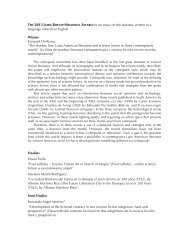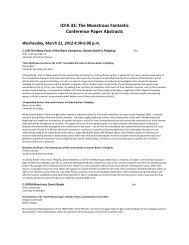The Uncanny and Monstrosity: Still More on the Tropology of SF
The Uncanny and Monstrosity: Still More on the Tropology of SF
The Uncanny and Monstrosity: Still More on the Tropology of SF
Create successful ePaper yourself
Turn your PDF publications into a flip-book with our unique Google optimized e-Paper software.
<str<strong>on</strong>g>and</str<strong>on</strong>g> <strong>on</strong> certain o<strong>the</strong>r tropes <strong>of</strong> thought, such as <strong>the</strong> “sf synecdoche,” which Anth<strong>on</strong>y<br />
Easthope defines as text “in which a single feature or group <strong>of</strong> features empirically<br />
plausible in our present world becomes extrapolated to occupy <strong>the</strong> whole space <strong>of</strong> an<br />
imagined future” (54).<br />
It’s probably obvious that my thinking about tropes is part <strong>of</strong> a much larger<br />
project <strong>on</strong> literature <str<strong>on</strong>g>and</str<strong>on</strong>g> rhetoric, a good porti<strong>on</strong> <strong>of</strong> which will be directly, perhaps even<br />
exclusively, about <strong>SF</strong>. At ICFA in 2009, I p<strong>on</strong>tificated about <strong>the</strong> tropes <strong>of</strong> narrative time,<br />
ending up saying something like within ficti<strong>on</strong>, all temporal structures are examples <strong>of</strong><br />
achr<strong>on</strong>y (anachr<strong>on</strong>ism), <str<strong>on</strong>g>and</str<strong>on</strong>g> <strong>the</strong>n tried to provide something <strong>of</strong> a catalog <strong>of</strong> <strong>the</strong> types.<br />
For instance, in distinguishing between analepsis <str<strong>on</strong>g>and</str<strong>on</strong>g> prolepsis, projecting backward or<br />
projecting forward, I followed <strong>the</strong> book About Time, where Mark Currie argues <strong>the</strong>re are<br />
three forms <strong>of</strong> prolepsis—narratological prolepsis (<strong>the</strong> flash-forward within a particular<br />
plot); structural prolepsis (<strong>the</strong> temporal difference between narrator <str<strong>on</strong>g>and</str<strong>on</strong>g> narratee); <str<strong>on</strong>g>and</str<strong>on</strong>g><br />
rhetorical prolepsis (“<strong>the</strong> anticipati<strong>on</strong> <strong>of</strong> an objecti<strong>on</strong> to an argument” [29]). If I tell you<br />
that my paper now will c<strong>on</strong>clude with a reference to <strong>the</strong> philosopher Avital R<strong>on</strong>ell, you<br />
have an example for <strong>the</strong> first, narratological prolepsis; if I speculate that right now you<br />
are muttering sotto voce, just what <strong>the</strong> hell does this have to do with anything?, <strong>the</strong>n<br />
you have an example <strong>of</strong> <strong>the</strong> third, rhetorical prolepsis. But it’s structural prolepsis that<br />
aligns most clearly with <strong>the</strong> distinctive quality <strong>of</strong> <strong>the</strong> literary, <str<strong>on</strong>g>and</str<strong>on</strong>g> especially so with sf.<br />
<str<strong>on</strong>g>The</str<strong>on</strong>g> difference between <strong>the</strong> text’s time <str<strong>on</strong>g>and</str<strong>on</strong>g> <strong>the</strong> reader’s time is always proleptic,<br />
since even if today yr reading China Miéville’s <str<strong>on</strong>g>The</str<strong>on</strong>g> City & <strong>the</strong> City, <strong>the</strong>re’s a temporal<br />
difference between when <strong>the</strong> book was written <str<strong>on</strong>g>and</str<strong>on</strong>g> <strong>the</strong> now <strong>of</strong> your reading. Structural<br />
prolepsis is <strong>the</strong>matic in <strong>SF</strong>: use Greg Bear’s City at <strong>the</strong> End <strong>of</strong> Time, <str<strong>on</strong>g>and</str<strong>on</strong>g> its retrocausal<br />
sum-runners as a paradigmatic instance.<br />
My general interest is that all <strong>of</strong> <strong>the</strong>se textual features have tropological<br />
structures. But I’m still very much at that cataloging phase, <str<strong>on</strong>g>and</str<strong>on</strong>g> if I fail here to give a<br />
thrilling inferential claim I hope you’ll forgive me. (Please note: that was just an example<br />
<strong>of</strong> rhetorical prolepsis.)<br />
Since I’ve found that many critics <str<strong>on</strong>g>and</str<strong>on</strong>g> scholars use various terms<br />
interchangeably, that that will cause c<strong>on</strong>siderable equivocati<strong>on</strong>. So let’s have a little<br />
semiological hygiene. I want, as <strong>the</strong> classical rhetoricians did, to make rigorous<br />
distincti<strong>on</strong>s between tropes <str<strong>on</strong>g>and</str<strong>on</strong>g> topoi, <str<strong>on</strong>g>and</str<strong>on</strong>g> I think c<strong>on</strong>flating <strong>the</strong>se two terms causes<br />
much c<strong>on</strong>fusi<strong>on</strong> in literary study, especially when we are trying to characterize <str<strong>on</strong>g>and</str<strong>on</strong>g><br />
define genres. Most <strong>of</strong> <strong>the</strong> time when people like us use <strong>the</strong> word trope, we probably<br />
should use topos. Topos is a Greek noun that can mean place or topic; for Aristotle, it<br />
was topic, <str<strong>on</strong>g>and</str<strong>on</strong>g> part <strong>of</strong> <strong>the</strong> first can<strong>on</strong> <strong>of</strong> rhetoric, inventio. This sort <strong>of</strong> topos c<strong>on</strong>cerns<br />
<strong>the</strong> types <strong>of</strong> approach in argument. But <strong>the</strong> o<strong>the</strong>r kind <strong>of</strong> topos that came to be<br />
important in literary study is <strong>the</strong> “comm<strong>on</strong> place” (koinos topos): <strong>the</strong>se are <strong>the</strong> comm<strong>on</strong><br />
place objects, events, settings, or stock characters; as regards <strong>SF</strong>, here’s <strong>on</strong>e <strong>of</strong> each:<br />
spaceships, c<strong>on</strong>ceptual breakthrough, a laboratory, <strong>the</strong> mad scientist. As <strong>on</strong>e instance<br />
<strong>of</strong> our typical equivocati<strong>on</strong>, take Gwyneth J<strong>on</strong>es, in <str<strong>on</strong>g>The</str<strong>on</strong>g> Cambridge Compani<strong>on</strong> to <strong>SF</strong>,<br />
who calls <strong>the</strong>se <strong>the</strong> “ic<strong>on</strong>s” <strong>of</strong> <strong>SF</strong>—that’s a very different idea. That her essay is<br />
o<strong>the</strong>rwise excellent doesn’t change <strong>the</strong> overdeterminati<strong>on</strong> <strong>of</strong> <strong>the</strong> terms.<br />
1600 years after Aristotle, ano<strong>the</strong>r kind <strong>of</strong> topos became important (you’ll find this<br />
in Aristotle too, both in <str<strong>on</strong>g>The</str<strong>on</strong>g> Rhetoric <str<strong>on</strong>g>and</str<strong>on</strong>g> <str<strong>on</strong>g>The</str<strong>on</strong>g> Topics, but <strong>the</strong> meaning has shifted<br />
radically): This is <strong>the</strong> eidos topos (literally “idea topic”), which Ernst Robert Curtius, in





